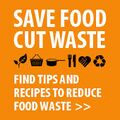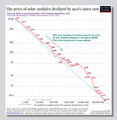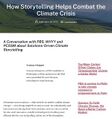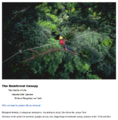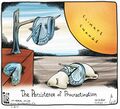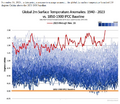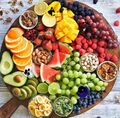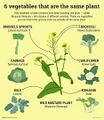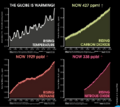Category:Food
Food and...
Preventative Medicine, check
Nutrition = Health, check
Food is nature's medicine, got it
So? So, Eat well and Prosper
--- Green Policy Food Tip for the Day
○ ○ ○ ○ ○ ○ ○ ○ ○ ○ ○ ○
Healthy Food is a Better Deal than Junk Food (like 'Duh)'
○ ○ ○ ○ ○ ○ ○ ○ ○ ○ ○ ○
Food 'Eco Labels Ecolabeling'
Food Ecolabeling, Definitions/Explanations from Kaiser Permanente
A lifetime of health comes down to the little actions we take every day, many of which happen in our grocery purchases. Those choices not only affect our own bodies, but also the global food chain and natural environment.
Food ecolabels score big points on what they can tell you about products:
American Grassfed
Animals were fed grass throughout their entire lives (after weaning), with no grain ever.
The animals had continuous access to pasture, and when weather conditions prevented them from grazing on pasture, they were given a grass-based forage.
The standards also prohibit antibiotics, growth hormones, and the use of certain parasiticides.
Animal Welfare Approved
Animals raised humanely on a family farm from birth to slaughter, with adequate and meaningful welfare protections and outdoor access.
One of the only animal welfare labels for poultry that requires access to pasture.
Bird Friendly
Found on coffee, this means that the farm where the coffee is grown is certified organic and maintains canopy for diverse bird habitat. (Coffee farms typically cut many trees to increase yields from coffee crops.)
BPI Compostable
Products that can break down into usable compost in a reasonable amount of time in the natural environment.
Compostable products are biodegradable, with the added benefit of introducing nutrients back into the soil.
Certified Humane Raised & Handled
Farms raising the animals met the Humane Farm Animal Care program’s standards for living conditions and treatment during transportation and slaughter.
Certified Humane standards also require prudent antibiotic use and prohibit artificial growth hormones and animal by-products in animal feed.
The label does not mean that chickens and pigs went outdoors, or that beef cattle and dairy cows had continuous access to pasture for grazing.
Fair Trade Certified
Products come from farms where farmers and workers are justly compensated.
Food Alliance Certified
Food produced on farms and processed in facilities that aim to meet standards of sustainable and responsible food production, including:
Reducing pesticide use through integrated pest management (rather than prohibiting all synthetic pesticides)
Soil and water conservation
Animal welfare
Wildlife and biodiversity conservation
Fair working conditions
Forest Stewardship Council
Forest/paper products used are from responsibly harvested and verified sources.
Green Seal
The product meets rigorous performance, health, and environmental criteria.
Certification backs up manufacturer’s environmental claims.
Helps consumers identify products that are safer for human health and the environment.
Marine Stewardship Council (MSC) Certified
Wild seafood caught using methods that do not deplete the natural supply.
Fishing companies do not cause serious harm to other life in the sea, from coral to dolphins.
Non-GMO Project Verified
Products made without the intentional use of genetically engineered ingredients (GMOs).
Best practices followed to prevent contamination with GMOs.
Does not guarantee the product is “GMO-free.”
Rainforest Alliance Certified
The farm where the product was grown meets Sustainable Agriculture Network standards, including:
Ecosystem conservation
Wildlife protection
Water conservation
Fair treatment and good working conditions for workers
Basic animal welfare practices
rBGH/rBST-free
Dairy from cows not injected with the genetically engineered hormone rBGH, also called rBST, to boost milk production.
Salmon-Safe
Farm uses agricultural practices that promote healthy streams and wetlands.
Found on beef, dairy, fruit, vegetables, legumes, beverages, etc.
USDA Organic
Food grown and processed following strict federal standards of sustainability and minimal synthetic inputs in farming and production.
○
FDA: How to Understand and Use the Nutrition Facts Label
US National Library of Medicine: Food Labeling
https://www.ams.usda.gov/sites/default/files/media/Organic4colorsealJPG.jpg
Subcategories
This category has the following 13 subcategories, out of 13 total.
Pages in category "Food"
The following 69 pages are in this category, out of 69 total.
A
C
E
F
G
- Generation Green
- Glasgow Climate Summit - Pledges, Promises, Declarations - What's Next Up
- Globally Important Agricultural Heritage Systems
- GP360 NewPages
- Green Best Practices
- Green Marketing
- Green New Deal
- Green Politics 360
- Green Stories of the Day
- Green Stories of the Day - GreenPolicy360 Archive
- GreenPolicy360 Archive Highlights 2013
- GreenPolicy360 Archive Highlights 2014
- GreenPolicy360 Archive Highlights 2015
- GreenPolicy360 Archive Highlights 2016
- GreenPolicy360 Archive Highlights 2017
- GreenPolicy360 Archive Highlights 2018
- GreenPolicy360 Archive Highlights 2019
- GreenPolicy360 Archive Highlights 2020
- GreenPolicy360 Archive Highlights 2023
- GreenPolicy360 Highlights
P
Media in category "Food"
The following 115 files are in this category, out of 515 total.
(previous page) (next page)- Robert W Kates.jpg 400 × 231; 43 KB
- Santa Clara Agrihoods.jpg 800 × 534; 147 KB
- Saudi Arabia and Middle East - Hot in May 2024.png 640 × 410; 506 KB
- Save Food.jpg 300 × 168; 5 KB
- SaveFood, CutWaste.jpg 200 × 200; 12 KB
- School strike for climate countries.png 800 × 411; 106 KB
- Science & Solutions - 2020 - Project Drawdown - NCSE Conf.jpg 800 × 351; 56 KB
- Science & Solutions - 2020 - Project Drawdown - NCSE.jpg 800 × 261; 66 KB
- SCOTUS EPA decision - June 30 2022.jpg 794 × 778; 168 KB
- Scoville-scale.png 479 × 800; 238 KB
- Seed-monopoly-consolidation-chart-2018.jpg 800 × 533; 318 KB
- Seeds of Change, published 1994.png 628 × 763; 915 KB
- Seeds of Change.jpg 260 × 346; 27 KB
- Seeds, time lapse.png 800 × 428; 297 KB
- Senate votes on methane - April 28, 2021.jpg 640 × 377; 77 KB
- Shell lawsuit Feb 2023.png 768 × 534; 229 KB
- Short Circuiting Policy - by Leah Stokes.jpg 595 × 423; 94 KB
- Slash emission now or face climate disaster.jpg 800 × 579; 94 KB
- Slow Food Initiatives 2015.png 1,004 × 802; 278 KB
- Slow Food.jpg 266 × 190; 11 KB
- SlowFood viatimthumb.jpg 620 × 300; 139 KB
- Soil and mycelium mycorrhizal fungi network threads.png 600 × 800; 699 KB
- Soil is the root stuff.jpg 483 × 960; 97 KB
- Soil Underground Life -1.jpg 750 × 600; 288 KB
- Solar panel price - 1976-2019.png 596 × 612; 92 KB
- SolarAqua Grid 2021.jpg 640 × 331; 116 KB
- Speed and Scale Action Plan.png 550 × 867; 132 KB
- Speed and Scale Poster.png 490 × 772; 101 KB
- State of the paris agreement nov2019.jpg 800 × 570; 178 KB
- Steven J Schmidt, May 2023.png 363 × 484; 383 KB
- Stop Wasting Food.jpg 900 × 679; 70 KB
- Story telling and science education.png 515 × 480; 171 KB
- StratDem logo4.png 316 × 100; 10 KB
- StratDem Strategic Demands.png 768 × 1,024; 626 KB
- Strawberry Festival! Florida.JPG 800 × 601; 564 KB
- Strike - Sept 20.jpg 754 × 754; 44 KB
- SunriseBmore March 1, 2021.jpg 593 × 622; 187 KB
- Supreme Court decision on GHG emission cost metric - May 2022.png 640 × 442; 419 KB
- Surprise climate deal.png 589 × 735; 83 KB
- Sustainable agriculture.jpg 960 × 360; 247 KB
- Telling stories of solutions for the climate crisis.jpg 600 × 640; 121 KB
- Temperature - SST World via Climate Change Institute - 2023 chart.png 800 × 509; 144 KB
- Temperature World - chart via Climate Change Institute.jpg 800 × 509; 67 KB
- Temperatures New Normal is Not Normal.jpg 582 × 461; 56 KB
- The Big Waste.png 640 × 420; 560 KB
- The Climate Dictionary - as of 2023.png 600 × 727; 200 KB
- The Greens Cookbook.jpg 116 × 225; 7 KB
- The New Climate War - Irish Times review 2021.jpg 792 × 2,048; 373 KB
- The Rainforest Canopy, the Richest Biosphere on Earth.png 745 × 757; 730 KB
- They Knew.jpg 287 × 428; 31 KB
- Thin Blue difference - approx 12 miles high.jpg 527 × 229; 37 KB
- Thin Blue difference.jpg 527 × 673; 147 KB
- Time for a Planet Update - Oct 31 2021.png 722 × 600; 852 KB
- Time Nov 10 2022 COP27.jpg 600 × 600; 92 KB
- Timeline-climate-change-history-485-million years.jpg 800 × 276; 42 KB
- Tipping Points - 2020.jpg 680 × 453; 65 KB
- To be fully alive is to work for the common good.png 612 × 819; 621 KB
- To serve - from Chef José Andrés.png 600 × 798; 535 KB
- Toby Hemenway-RIP Dec2016.png 503 × 327; 32 KB
- Toles - Dali - Climate.jpg 449 × 407; 51 KB
- Tom Lovejoy on Biological Diversity.png 594 × 180; 48 KB
- Tom Lovejoy Planet Citizen.png 594 × 257; 25 KB
- Too Hot - FT.png 600 × 651; 220 KB
- Too Hot in India - Apr 2022.png 560 × 480; 120 KB
- Too Hot in US - 2.png 800 × 221; 124 KB
- Too Hot July 17 2023.png 640 × 439; 162 KB
- Too Hot US June 2022.png 695 × 543; 483 KB
- Too Hot, a new heat record - Nov 18 2023.png 788 × 680; 680 KB
- Toward the Hothouse.png 800 × 337; 160 KB
- Tracking Biden's Environmental Record - WaPo - Feb 2021.jpg 766 × 326; 64 KB
- Tracking Biden's Environmental Record - WaPo listing - Feb 2021.jpg 588 × 397; 35 KB
- Trump promise to oil ceo gathering - 1.png 440 × 108; 19 KB
- Trump promise to oil ceo gathering - 2.png 480 × 495; 291 KB
- Trump promise to oil ceo gathering - 3.png 480 × 284; 270 KB
- Trump promise to oil ceo gathering - 4.png 480 × 480; 333 KB
- TS-CMU-Green.jpg 406 × 526; 54 KB
- UN - Tipping Point for Climate Action.png 690 × 600; 601 KB
- UN Climate Summit News (1).pdf ; 1.85 MB
- UN NDC Registry - website database.png 798 × 392; 575 KB
- Union Oil Spill On the Calif Coast - February 1969.png 640 × 351; 371 KB
- Union Oil Spill On the Calif Coast - January 1969.png 640 × 326; 196 KB
- Unprecedented report - IPCC Aug-9-2021.jpg 800 × 666; 165 KB
- Update - James Hansen July 2023 'We are fools'.png 595 × 800; 610 KB
- US 2020-billion-dollar-disasters-map.png 800 × 480; 259 KB
- US Annual Temperatures 1901-2020 Average Comparison.jpg 604 × 843; 242 KB
- US EPA to reverse methane rules.jpg 592 × 745; 175 KB
- US Quits Climate Accord.jpg 795 × 233; 40 KB
- US River basins - watersheds.jpg 800 × 477; 131 KB
- US Senate passes 430 billion climate bill.png 468 × 396; 213 KB
- Usable climate science is adaptation science-Adam Sobel May 2021.jpg 702 × 664; 155 KB
- Vegans and animal agriculture.jpg 320 × 320; 16 KB
- Via Dr Stacey Robinson.JPG 800 × 789; 238 KB
- Vorsorgeprinzip at GreenPolicy360 - sjs.png 611 × 758; 164 KB
- WaterConservation.jpg 361 × 545; 26 KB
- We are all crew.jpg 448 × 181; 17 KB
- We are all in this together-IPCC report-August 2021.jpg 513 × 768; 183 KB
- We must flatten the curve, yes ... August 2020.jpg 800 × 421; 99 KB
- We're related mustard greens.jpg 467 × 540; 45 KB
- What happens when.png 585 × 215; 20 KB
- When your house is on fire.jpg 589 × 473; 77 KB
- Which countries pollute the most ~2017.jpg 800 × 422; 69 KB
- Who really invented the climate stripes - Climate Change Education.png 600 × 600; 234 KB
- Why is the Amazon burning - Katharine Hayhoe explains.jpg 498 × 763; 149 KB
- Winning on the climate legis - AOC.png 480 × 519; 249 KB
- WV v EPA SCOTUS poll - June 27 2022 before court decision.png 623 × 480; 126 KB
- Youth Climate Movement.jpg 516 × 284; 79 KB
- Youth vote estimates 2016 primary.png 800 × 490; 257 KB
- Zack Labe - climate viz - June 2024.png 675 × 600; 261 KB




